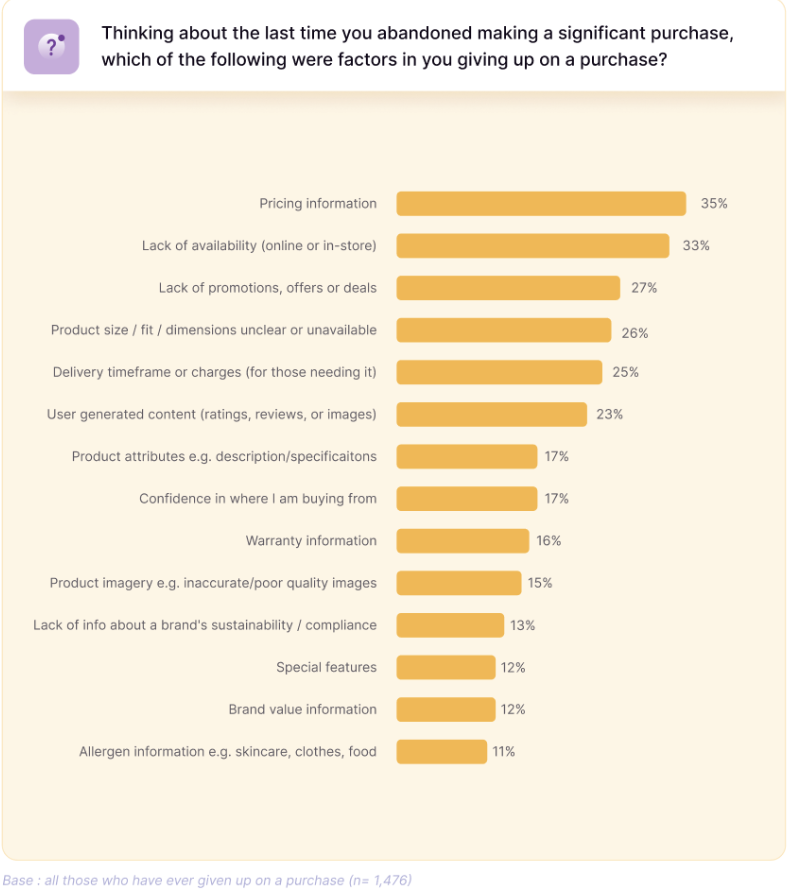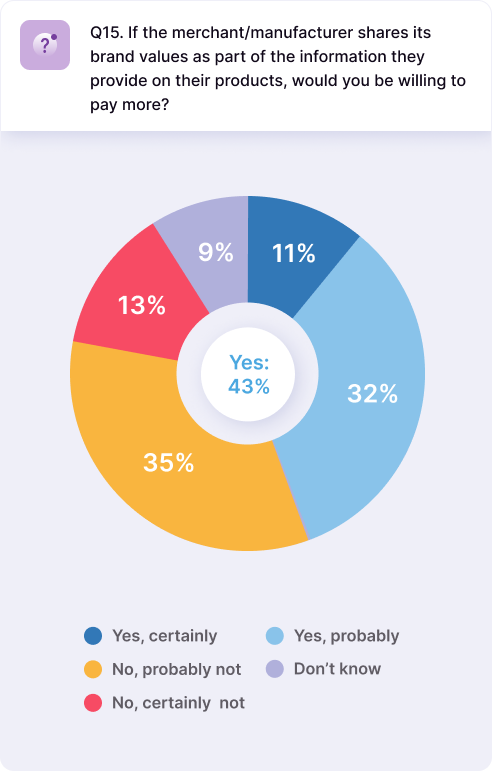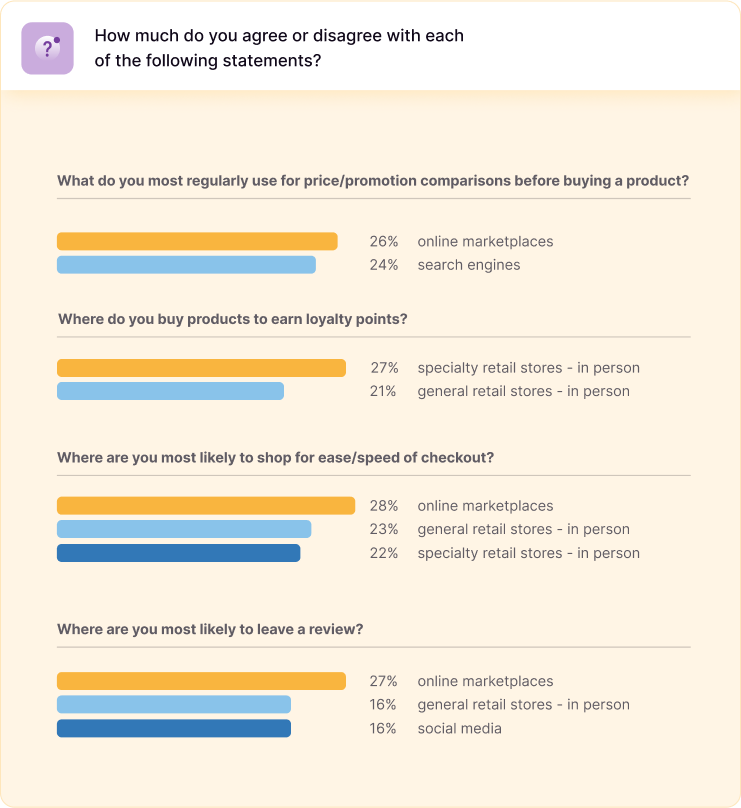Jul 03, 2023
6 min to read
Our 2023 B2C Survey uncovered that many consumers are feeling the strain of the economy. In the midst of a cost-of-living crisis, discover how to forge strong consumer relationships and stay competitive with these 5 tips to delight customers.

Shaped by the cost-of-living crisis, customer demands have taken a new direction; two-thirds of consumers now spend more time validating purchases to ensure they’re getting the best bang for their buck. Not only is today’s consumer more discerning and better informed than years past, their buying decisions are increasingly driven by price. To earn the loyalty of shoppers today, brands must be able to provide high-quality products and personalized shopping experiences, all while keeping prices as competitive as possible.
In our 2023 B2C survey, we aimed to find out what product information consumers care about the most, and discovered that pricing information and information about promotions, offers, or deals ranked as most important. In fact, they often ranked as more important than product size, fit, or dimensions information. Clearly consumers are actively seeking out ways to save money and are highly receptive to the brands that help them do so.
It’s now even more important for brands to show additional value beyond the quality of their product. Earning loyalty during economic uncertainty means finding new ways to delight consumers.
The economic shift has led to customers seeking more than just basic product details. For the first time, we decided to explore this trend in our survey, asking about availability information as a significant factor in their purchasing decisions. We found that 25% of respondents do look for availability information before making a purchase decision. However, the true impact of product availability is even larger.
In fact, 82% of consumers have given up on completing a significant purchase. The most common culprits for the abandoned cart? Lack of availability and price.
For brands, this means incorporating more transparency into product data. Consider listing when out-of-stock products will return or allow customers to purchase now with shipping available on a future specified date. Providing clear shipping time estimates before purchase will also have a positive impact on consumers. Simply put, the more information you’re able to provide, the more confident consumers will feel in their purchase decision.


Consumers are putting their dollars where their values are, paying close attention to a brand’s values and company practices before making a purchase. Our survey dove further into value-driven purchasing, and found that 43% of consumers would be willing to pay more brands that showcase their brand values. In fact, those that answered “yes” would be wiling to pay an average of 18% more.
Specifically, sustainability ranked as one of the values most prioritized by shoppers, with 35% seeing sustainability as a key piece of product information. As consumers increasingly look for brands that align with their values and are making sustainable choices, this provides another opportunity for brands to delight their customers and foster loyalty.
Be intentional about sharing your brand’s sustainable and ethical practices. Behind-the-scenes videos, educational blogs, events, community discussions, and more can all highlight company values, working to build strong relationships with consumers who share the same priorities.

In the world of retail, returns can often mean additional costly shipping logistics, plus processing and restocking fees, causing headaches for both consumers and brands alike. Though returns, unfortunately, will likely never drop to zero, brands can reduce their return rate with a focus on product information. A notable 54% of consumers have returned products due to incorrect pre-purchase product information. In a time where consumers are counting every dollar, this poor experience and the stress of a return can cause irreparable damage to brand trust. Businesses must ensure that product information is detailed and accurate to avoid unnecessary returns and dissatisfaction.

When a return is necessary, consumers expect it to be easy and stress-free. A whopping 40% of consumers rank an easy return process as one of the top two services a retailer should offer, making it a significant component of the customer experience. In fact, two-thirds of consumers say they would become a loyal customer if a brand offered a more compelling shopping experience, including stress-free returns. Moreover, 63% of consumers express a negative feeling about a retailer charging them for returning a product, indicating the need to make returns as seamless as possible.
Research shows free returns may be financially unsustainable for brands, but offering free in-store returns and paid returns via shipping is a great compromise. This balances the customer’s need for a simple and cheap return process with the brand’s economic health, as in-person returns remove high operational costs and make managing stock and inventory that much easier. However, the best return is no return at all, so be sure to prioritize the completeness and quality of product information pre-purchase to reduce unnecessary returns.

One of the biggest changes in consumer behavior due to the cost of living crisis revolves around the decision-making process. Two-thirds (66%) of consumers now spend more time validating purchases and require more information before making a purchase. Consumers are looking for more detailed product information, including pricing and availability, to ensure that they are making an informed decision and getting the best value for their money.
The importance of providing accurate and detailed product information at every touchpoint cannot be overstated. In fact, over 62% of consumers would purchase a different product than the one they originally intended to buy due to a lack of product information. Plus, product data mishaps can have lasting impacts. It only takes one bad product information experience to cause a consumer to give up on a brand forever, according to 63% of consumers surveyed.


In today’s day and age, consumers are seeking a truly omnichannel experience that seamlessly blends their online and in-store shopping experiences. But be careful to include the right amount of information on each channel. According to our 2023 survey, 71% of consumers say they find additional product information when they look in multiple places. This can be cause for some concern. Consumers should be able to find the right amount of product information to fuel a purchase no matter which channel they’re on. Forcing your consumers to search in different places to get the information they need could spark them to turn to a competitor site or simply give up on the purchase altogether, seriously impacting revenue.
This highlights the importance of having a consistent and cohesive omnichannel strategy that provides consumers with accurate and comprehensive product information across all channels. And don’t forget, a bad product information experience from any source can result in 60% of consumers abandoning their purchase. So not only do brands need to show up on the right channels tailored to the right devices, but they need to ensure that they’re providing the best product experience – meaning accurate and consistent product information, branding, and messaging – everywhere.
New technologies can be incredibly helpful when it comes to creating a stand-out omnichannel experience. Almost two-thirds of consumers are interested in utilizing innovative technologies such as chatbots, voice assistants, and VR tools when shopping. Sales support tools such as mobile apps and virtual reality tools like augmented reality applications are the most sought-after tools by consumers to help them make informed shopping decisions. Our survey found that an investment in technology can seriously pay off for brands. Around 41% of consumers are willing to pay more for a more exciting and compelling shopping experience, and two-thirds of consumers say they would become loyal customers if a brand or retailer offered a more engaging shopping experience.
But be careful – consumers don’t want to be confined to just the online world. When considering a purchase, consumers rely heavily on both store salespeople and search engines as their top sources for professional advice. While online marketplaces and search engines are the most likely places consumers use for product discovery, 20% still regularly visit general and specialty retail stores in person to discover new products. What’s more, 84% of consumers have researched products online before buying in a store, and 77% have browsed products in-store but purchased online. What does it all mean? Providing consumers with a seamless omnichannel experience across both online and in-store shopping experiences, with accurate product information, innovative technology, and a unique and personalized shopping experience can lead to increased customer loyalty and sales.

While customer expectations are on the rise, the cost of living crisis and uncertain economic conditions have made providing additional value even more critical for brands in order to off-set a renewed focus on price. Retailers must find a balance between meeting consumer demands for high-quality products and personalized shopping experiences while also providing competitive pricing and promotional offers. Providing transparent pricing and availability information, detailed product information, and promotional offers can help retailers build trust with consumers and remain competitive in the market.
Want to delve into even more emerging customer trends and actionable insights into today’s shopper? Download the full 2023 Global B2C Survey Results Report today, or reach out to an Akeneo expert today to get started on your journey towards better product experiences.
Sign up for our newsletter and stay ahead of the curve on everything you need to know about product information management, product experience management and how to unlock growth for your organization.
